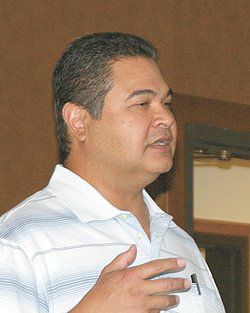John Baza, the director of the Utah State Division of Oil, Gas and Mining told the Emery County Public Lands Council of how the division handles leasing properties for oil and gas exploration. “This process I am explaining is for private landowners only. The process for oil and gas exploration and mining on public lands is very different,” Baza said.
The Utah DOGM is comprised of four departments, oil and gas, coal, minerals, and abandoned mines and reclamation. DOGM answers to the Utah Board of Oil, Gas and Mining which is comprised of seven private and industry people. DOGMs job is to regulate and ensure industry compliance and site restoration while facilitating oil, gas, and mining activities. Their responsibilities are strongly tied to, but not exclusively, the energy industry.
An oil, gas or mining company is comprised of three divisions, exploration, land, and production. The exploration division consists of the manager, geologists, geophysicists, technicians, administrative personnel, and information specialists.
The land department is made up of a manager, landmen, legal, lease analysts, administrative personnel, and brokers.
Someone who is considering leasing his property for mineral exploration should contact the land department of any company.
As for production of the minerals on a portion of property, the final department, production, will handle all operations of the engineering and production of a site.
A landowner should consider many things before leasing his property to a company. He should consider his own landowners rights, the benefits of leasing, the components of the lease and issues related to his land.
Once a lease agreement is signed, the private landowner may have no more rights to the land until the drilling, mining and reclamation process is completed or to the end of the lease.
The landowner should also consider whether he wants to be a royalty owner, a working interest owner, a pooling partner, a unitization partner, or involved in correlative rights protection. Before signing a lease, a landowner should thoroughly research who is offering the lease, who is doing the dealing (landman, broker, leasing agent, etc.), what the lease means, the terms of the lease, and the deadline for signing.
The key components to a lease usually are, payment conditions, rental fees, royalty fees, and termination. Other issues to consider are disturbance to the land, damage to crops, buildings and other personal property, and lease assignments.
DOGMs rules affecting landowners differ from oil and gas to mining. Each purpose is regulated. DOGM will also oversee the permitting and well location, predrilling evaluations, plugging and abandonment, and well site restoration.
DOGM will also help with payment timing requirements, unpaid proceeds, and payment information to royalty owners.
Sherrel Ward asked Baza about surface rights and mineral rights. Baza said, “If the surface owner and the mineral owner of a piece of property are different, the mineral owner has the right of access and the right to place a well site. But, the mineral owner must not harm the surface owners rights. They must agree together to any drilling project.”
For more information concerning leasing, call 801-538-5340 or visit http://ogm.utah.gov.
DOGM reports on how the oil and gas leasing permits work

"John Baza speaks about oil and gas permitting."
